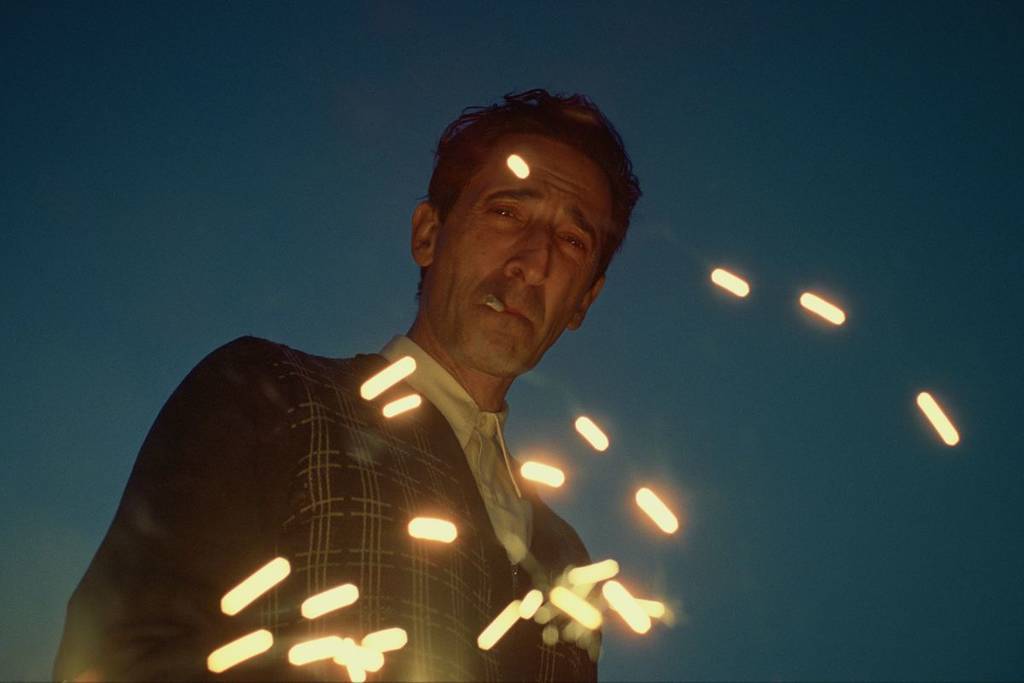The Brutalist: Means Without Purpose
Beyond the natural ambitions of a grand film, Brady Corbet’s The Brutalist raised high expectations among the architectural world and a growing audience passionate about design. The promise lay, first and foremost, in finally having an interesting architect as the main character – played by an Adrien Brody seemingly perfect for the role, as an individual of substance and depth, not a prisoner of the drawing board trapped in an impenetrable professional jargon (which is often the case in reality). Then, the entire story was meant to depict the architect’s struggle and the personal cost of the compromises he is forced to make in his heroic effort to practice architecture as an art form despite life’s adversities – an everyday, unspectacular, and frustrating reality many architects face. On top of that, of course, there was the promise of breathtaking set designs unfolding before our eyes over 215 minutes, reminding us of a time when “the hard core of beauty” had not yet been swallowed by capitalist commodification, and architects dreamed not only of rebuilding cities destroyed by World War II bombings but also of engineering their social fabric. But in The Brutalist, the architectural movement serves more as a pretext for Corbet to indulge in a series of references he enjoys – like an enthusiastic architecture student.
The film has been a major success, claiming, among other accolades, a Silver Lion, four BAFTAs, two Golden Globes, and three Academy Awards (including for Best Actor), with some critics’ reviews verging on the ecstatic. Peter Bradshaw, writing for The Guardian, praises the “bold and wildly ambitious epic,” while The Hollywood Reporter’s David Rooney swiftly attempts to dispel any notion that Ayn Rand’s infamous 1943 novel The Fountainhead served as an overwhelming inspiration for Corbet. Yet, the extent to which it appears to have influenced the film is rather embarrassing. From the theme of the architect’s coexistence between precarity and a God complex to his toxic relationship with his patron and down to specific conversations and situations – a particularly strong opinion on marble, for instance – the echoes of The Fountainhead are unmistakable, even if The Brutalist does not mirror Rand’s ideology. Beyond the awards and praise from mainstream publications and industry audiences, Corbet seems intent on impressing architects as well, filling the film with in-jokes and obscure references. For instance, in the very first minutes, his protagonist tells a sex worker that he cannot relax because he dislikes the proportions of her forehead.
The Brutalist tells the story of László Tóth, a Hungarian-born Jewish architect who survives the Buchenwald concentration camp and emigrates to America, where he attempts to revive the promising career he had started before the war under the patronage of a socially powerful yet temperamental client, Harrison Lee Van Buren (Guy Pearce). As the epic unfolds, Tóth becomes increasingly entangled in a cruel fate: first, his cousin Attila (Alessandro Nivola) throws him out onto the street shortly after offering him a chance to design avant-garde furniture at his family’s workshop. In the shelter where he takes refuge, he meets Gordon (Isaach De Bankolé), who teaches him to inject heroin – a quick escape from psychological pain that soon turns into addiction. Van Buren, the patron who gives him a second chance at professional fulfillment, proves to be a brute, stripping Tóth of even the last shreds of his dignity. (A none-too-subtle play on the film’s title and its lingering question: Who is the real Brutalist?)

Tóth’s wife, Erzsébet (Felicity Jones), and their niece, Zsófia (Raffey Cassidy), initially stranded in Budapest, finally manage to join him in Philadelphia just as he is immersed in what seems to be the defining project of his career. But even reunited, the weight of the past looms over them: Erzsébet suffers from unbearable osteoarthritis pain caused by the freezing conditions endured in the camp, while Zsófia refuses to speak.
The architectural vision for “The Institute” (a sacred space dedicated to the memory of Van Buren’s mother, which keeps expanding with public and cultural functions, eventually including a vast underground cistern) consumes Tóth, fueling both his self-destructive tendencies and heroin addiction. The construction’s repeated halts and resumptions mirror Tóth’s cycles of decline and temporary recovery, echoing not only literary clichés (“one must suffer for art”) but also the distant perceptions of the architectural world (“the best description of a cube, alas, is its own construction”). Like his Brutalist protagonist, Corbet piles these unfulfilled destinies into an unreadable and haunted cinematic structure, nearly crushed under the weight of moments that lead nowhere and gratuitous outbursts of violence.
Yet, after years of struggle, Tóth ultimately receives the recognition he once sought in his youth – a retrospective of his work at the 1980 Venice Biennale. There, his niece Zsófia – though the film never explains how she regains her speech – delivers what seems to be the film’s ultimate message: “It’s not the journey that matters, but the destination.”
For architects, the Biennale moment is also the film’s most glaring anachronism, considering that Paolo Portoghesi’s 1980 Biennale is a landmark for postmodernism. Only today do we see our feeds flooded with what one might call a “brutalist revival,” blending béton brut with aspirations for a “minimalist” lifestyle in a neoliberal reification of 1950s brutalism. But in 1980, at the Venice Biennale, Portoghesi’s main concern was to cement postmodernist critique within international discourse, heralding the rising wave against the so-called monotonous simplicity of architectural modernism.
Brutalism emerged in the 1950s as a practice among various architects (including some trained at the Bauhaus, like Corbet’s protagonist – for instance, Marcel Breuer, a key inspiration in shaping Tóth’s biography) who were testing the expressive possibilities of concrete, a material devoid of cultural memory, in the construction of social housing or monuments intended to erase class distinctions. In other words, “brutalism” – today, a label stuck onto any exposed concrete surface in gentrified neighborhoods – could never have been revisited with praise at a Biennale filled with historical references and explicit irony toward modernism. Of course, the Biennale episode in The Brutalist may be meant as a counterfactual, Tarantino-esque ending, an early historical reparation for brutalism. Within the film’s economy, this is the only thing that was missing.
“It’s the destination that matters” is not the only aphorism with which Corbet adorns his narrative (which is far from being fully summarized above, despite what one might think). The numerous references to architectural culture serve to counterbalance the pervasive darkness with the solace of beauty, and Corbet proves almost pedantic in emphasizing the fact that Tóth is an architect. As soon as he arrives in Philadelphia, Tóth makes a point of demonstratively asserting his place within the intellectual elite of a profession the average American does not frequent – a fact made evident by his client Harrison Lee Van Buren’s mental breakdown upon seeing the overly austere library Tóth designs for him (a beautiful piece of production design by Judy Becker).
Architects may seem unreasonable in accusing Corbet of not understanding the art he used as mere set dressing. But what, in the end, did Corbet truly gain by inventing his architect from scratch instead of making a biopic about someone who embodied even half of Tóth’s story? The first answer that comes to mind is: none of them looked like Adrien Brody. And that was probably the only thing that mattered.
Much like Howard Roark, Ayn Rand’s protagonist in The Fountainhead, Tóth refuses to compromise his professional ideals. His Bauhaus training both obligates and empowers him: as he prepares the final details of the reading room before the client’s arrival, he places a tubular steel-framed chair into the very center of the space, right where (surprise, surprise) the light from an oculus falls. Tóth is full of such precious gestures in the film’s first part, The Enigma of the Arrival, including when he presents the massive model of the multi-functional “Institute” building to a local committee, positioning his flashlight over a cutout in the floor plan: “This is how it looks when the sun rises,” he says, leaving us to imagine the rest. (Earlier, we had already learned that it looks somewhat like Tadao Ando’s Church of the Light.)
The film’s second part, The Hard Core of Beauty, is where Corbet reveals himself to be well-versed in the things architects appreciate. His formalist attempt at a Tarkovskian aesthetic provides the perfect excuse to turn the underground level of the multi-functional center – built on a hillside – into a dark, cistern-like abyss, whose flooded depths seem to house the very evil that haunts Tóth. The basement, the only element capable of bringing coherence to the otherwise fragmented building – according to the architect – becomes a representation of his tormented psyche. Furthermore, Corbet seems to suggest that Tóth’s architectural references for this part of the building might even have been Buchenwald and Dachau – a rather bizarre memorialistic attempt. (To my knowledge and imagination, it seems unlikely that an architect, especially one who survived such an experience, would go so far as to symbolically recreate the space of his own torture.)
Depending on the construction progress of the “Institute” – an oversized monument that moves forward, then stagnates, and so on – Tóth becomes a bundle of nerves, ready to lash out at his client, construction managers, and others, with violent outbursts: “Everything that’s ugly, cruel, stupid, but especially ugly, is your fault!” This stands in stark contrast to the calm, “Olympian” demeanor one might expect from a former student of Walter Gropius, who was himself known for his composure (as described, for instance, by Polish architect Helena Syrkus, a fellow member of the International Congresses of Modern Architecture).
Built along the biographical lines of architects like Marcel Breuer, Louis Kahn, or Paul Rudolph, László Tóth reaches an almost irritating level of realism for architects because he remixes history along seemingly precise coordinates while ultimately remaining foreign to it – much like what AI might do with a well-crafted prompt. Tóth swallows history itself – he is the avant-gardist, the modernist, the brutalist, and insists on also being the figure reclaimed by the imagined anachronistic revival of the 1980 Biennale. He is the starchitect and the marginalized immigrant, the ruined man, the survivor, and the winner. His architecture resembles that of Modern Movement pioneers but also that of Louis Kahn (who defies strict categorization) and Tadao Ando, yet it belongs to none of them.
When Corbet asked renowned architectural historian and theorist Jean-Louis Cohen if he could think of an architect who had followed Tóth’s trajectory, Cohen said no. Criticizing the film primarily for distorting the history of modernist architecture would be a mistake because, despite appearances, The Brutalist is not truly about architecture – it wants to remain a secondary concern. Architects may seem unreasonable in accusing Corbet of not understanding the art he used as mere set dressing. But what, in the end, did Corbet truly gain by inventing his architect from scratch instead of making a biopic about someone who embodied even half of Tóth’s story? The first answer that comes to mind is: none of them looked like Adrien Brody. And that was probably the only thing that mattered.
Title
The Brutalist
Director/ Screenwriter
Brady Corbet
Actors
Adrien Brody, Felicity Jones, Guy Pearce
Country
SUA, Marea Britanie, Ungaria
Year
2024
Distributor
Ro Image 2024

Ilinca Pop
A absolvit arhitectura la UAUIM și are un doctorat în istoria și teoria arhitecturii, iar din 2019 e asistentă colaboratoare a catedrei Istoria & Teoria Arhitecturii și Conservarea patrimoniului a UAUIM. A mai scris în PLAT, sITA, COTAA și Scena 9, iar din 2020 e redactor colaborator Zeppelin. Dintotdeauna și-a dorit mai degrabă să scrie despre case decât să le proiecteze.


